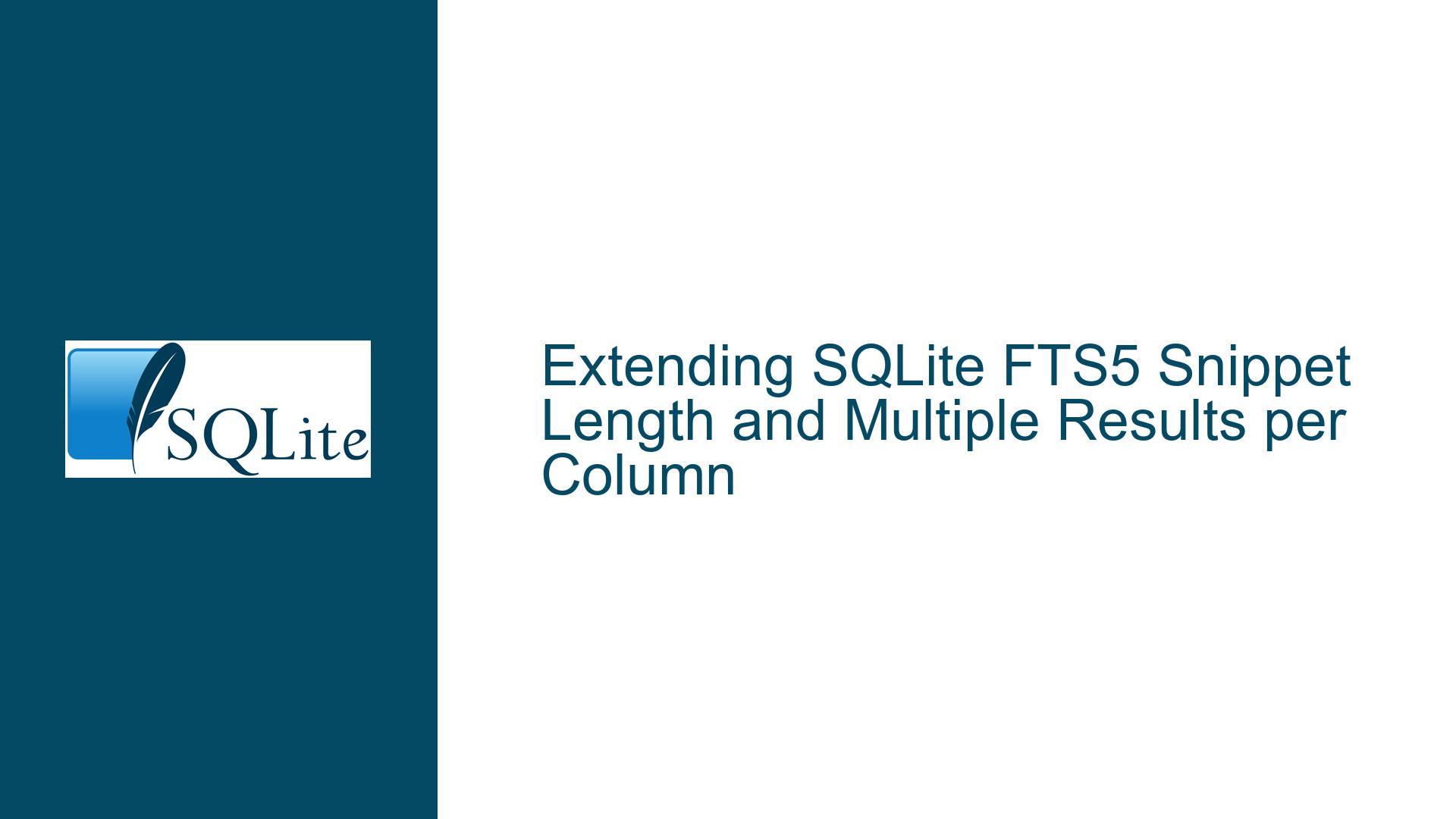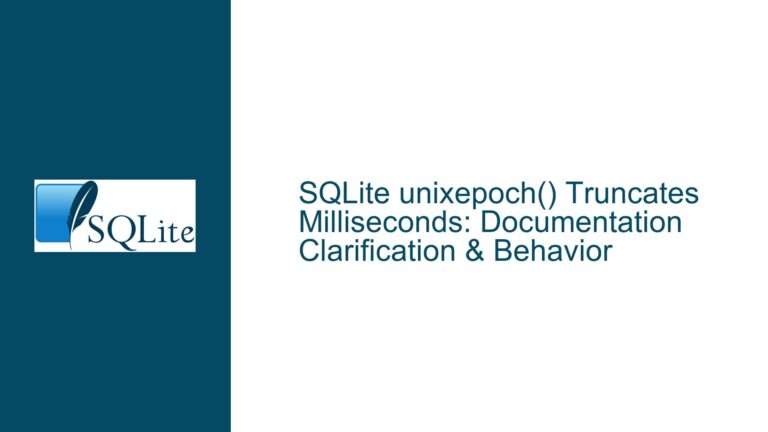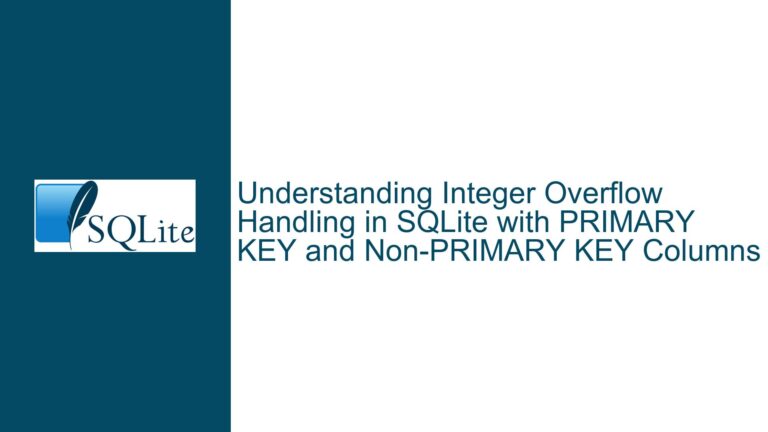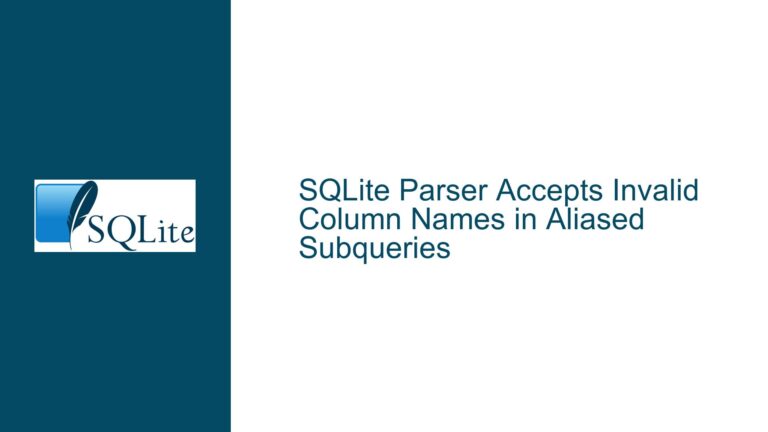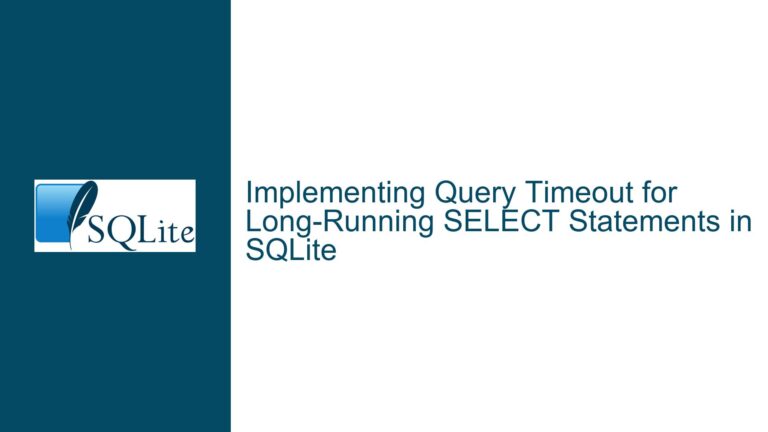Extending SQLite FTS5 Snippet Length and Multiple Results per Column
Understanding the Limitations of Default FTS5 Snippet Generation
The core challenge revolves around extending SQLite’s Full-Text Search (FTS5) snippet capabilities beyond their default constraints. The built-in snippet() function currently produces maximum 64-character fragments and returns only one highlighted excerpt per matched column. To achieve longer snippets with multiple fragments per column cell, developers must implement custom auxiliary functions while addressing several architectural considerations.
Three critical areas require examination: FTS5’s tokenization pipeline, buffer management strategies in snippet generation, and Unicode text segmentation complexities. The interaction between these components dictates whether custom implementations can successfully override default behaviors without introducing performance degradation or text corruption. Successful extension requires modifying snippet length parameters, implementing multi-fragment accumulation logic, and enhancing boundary detection algorithms – particularly for languages requiring advanced text segmentation rules.
Architectural Constraints in FTS5 Auxiliary Function Implementation
The primary obstacles stem from FTS5’s design as a balance between performance and functionality. While the auxiliary function API allows customization, several implicit constraints emerge:
Tokenization Context Mismatch
FTS5 snippet generation operates on the tokenized representation of text rather than raw document content. Custom implementations must either:- Reimplement tokenization matching the original FTS5 table’s configuration
- Access raw document content through contentless/optimized FTS5 tables
- Maintain parallel tokenization contexts
Mismatches between snippet generator tokenization and FTS5 table tokenization lead to incorrect highlight positioning. The default Unicode61 tokenizer handles basic word boundaries but struggles with complex scripts.
Buffer Management Limitations
SQLite’s default snippet implementation uses fixed-size buffers that enforce the 64-character limit. Custom functions must implement dynamic buffer allocation while preventing memory exhaustion attacks through configurable maximum lengths.Highlight Span Propagation
Multiple fragment generation requires tracking highlight positions across potentially overlapping token matches. The default FTS5 phrase matching algorithm wasn’t designed for multi-fragment output, risking either incomplete highlight coverage or redundant fragment duplication.Collation Sequence Interactions
Custom snippet generators must honor the FTS5 table’s defined collation sequences when matching search terms, requiring collation-aware string comparison in highlight detection logic.Contentless Table Challenges
When working with contentless FTS5 tables (common in large document scenarios), raw text retrieval requires separate storage integration. This introduces consistency maintenance challenges between the external content source and FTS5 index.
Implementing Custom Snippet Generation with Extended Capabilities
A robust implementation requires modifying three layers: FTS5 integration, text processing, and result assembly. Below is the technical blueprint:
Phase 1: FTS5 Auxiliary Function Registration
Create a custom SQL function using sqlite3_create_module_v2() that extends FTS5’s auxiliary function capabilities. Key implementation steps:
typedef struct MultiSnippetContext {
sqlite3_context *pCtx; // SQL function context
int iCurrentFrag; // Fragment counter
int nFragGoal; // Target fragment count
int nMaxLength; // Maximum snippet length
Fts5ExtensionApi *pApi; // FTS5 API methods
Fts5Context *pFts; // FTS5 table context
const char *zDoc; // Full document text
int nDoc; // Document length
} MultiSnippetContext;
static void fts5_snippet_xFunc(
const Fts5ExtensionApi *pApi,
Fts5Context *pFts,
sqlite3_context *pCtx,
int nVal,
sqlite3_value **apVal
){
MultiSnippetContext *p = sqlite3_malloc(sizeof(*p));
p->pApi = pApi;
p->pFts = pFts;
p->pCtx = pCtx;
// Parse parameters: column index, max fragments, max length
int iCol = sqlite3_value_int(apVal[0]);
p->nFragGoal = nVal>1 ? sqlite3_value_int(apVal[1]) : 3;
p->nMaxLength = nVal>2 ? sqlite3_value_int(apVal[2]) : 256;
// Retrieve full document text - requires content table
p->pApi->xColumnText(pFts, iCol, &p->zDoc, &p->nDoc);
// Process document and build snippets
generate_multiple_snippets(p);
sqlite3_free(p);
}
Phase 2: Advanced Text Boundary Detection
Integrate ICU’s BreakIterator for accurate word/sentence boundaries:
#include <unicode/ubrk.h>
#include <unicode/utext.h>
void find_text_boundaries(const UChar *text, int32_t length) {
UErrorCode status = U_ZERO_ERROR;
UText *ut = utext_openUChars(NULL, text, length, &status);
UBreakIterator* bi = ubrk_open(UBRK_WORD, "en_US", NULL, 0, &status);
ubrk_setUText(bi, ut, &status);
int32_t start = ubrk_first(bi);
while(start != UBRK_DONE) {
int32_t end = ubrk_next(bi);
if(end == UBRK_DONE) break;
// Store start/end offsets for word boundaries
add_word_boundary(start, end);
start = end;
}
ubrk_close(bi);
utext_close(ut);
}
Phase 3: Multi-Fragment Highlight Aggregation
Implement fragment collection with overlap prevention:
#define MAX_FRAGMENTS 5
typedef struct Fragment {
int start;
int end;
int score;
} Fragment;
void generate_multiple_snippets(MultiSnippetContext *ctx) {
Fragment fragments[MAX_FRAGMENTS];
int fragCount = 0;
// Find all match positions using FTS5 API
Fts5PhraseIter iter;
const char *zTerm; int nTerm;
int iCol = 0;
int rc = ctx->pApi->xPhraseFirst(ctx->pFts, 0, &iter, &iCol, &zTerm, &nTerm);
while(rc == SQLITE_OK){
int iStart = 0, iEnd = 0;
while(0 == ctx->pApi->xPhraseNext(ctx->pFts, &iter, &iStart, &iEnd)){
// Calculate fragment boundaries around iStart/iEnd
int fragStart = find_left_boundary(ctx->zDoc, iStart);
int fragEnd = find_right_boundary(ctx->zDoc, iEnd);
// Score fragment based on match density
int score = calculate_fragment_score(ctx, fragStart, fragEnd);
// Add or merge with existing fragments
manage_fragment_list(fragments, &fragCount,
fragStart, fragEnd, score);
}
rc = ctx->pApi->xPhraseNext(ctx->pFts, &iter, &iStart, &iEnd);
}
// Sort fragments by score and select top N
qsort(fragments, fragCount, sizeof(Fragment), compare_fragments);
output_highlighted_snippets(ctx, fragments, fragCount);
}
Critical Performance Considerations
Document Text Caching
Implement LRU caching for document content retrieval when using contentless tables to avoid repetitive external storage lookups.Boundary Analysis Optimization
Precompute text boundaries during FTS5 indexing using custom tokenizer hooks, storing boundary offsets in shadow tables for rapid snippet generation.Match Position Indexing
Extend FTS5 phrase iteration with positional bitmap indexes to accelerate multi-fragment collection, trading index size for O(1) match lookups.Highlight Rendering Pool
Use thread-local memory pools for highlight HTML span allocation to prevent malloc contention in high-concurrency environments.
Unicode Handling Deep Dive
For languages with complex word boundaries (e.g., Thai, Japanese), integrate ICU’s line break detection with custom rules:
UBreakIterator* create_custom_break_iterator(const char *locale) {
UParseError parseErr;
UErrorCode status = U_ZERO_ERROR;
const char *rules =
"!!chain;"
"!!forward;"
"\\p{LineBreak=Complex_Context} $sentence;"
"[:LineBreak=Conditional_Japanese_Starter:];";
UBreakIterator* bi = ubrk_openRules(
rules, strlen(rules),
NULL, 0,
&parseErr, &status
);
if(U_FAILURE(status)){
log_icu_error(status, parseErr);
return ubrk_open(UBRK_WORD, locale, NULL, 0, &status);
}
return bi;
}
Security Considerations
Output Sanitization
Implement HTML entity encoding when wrapping matches in tags to prevent XSS injection from document content:void append_escaped_text(StringBuffer *buf, const char *z, int n){ while(n-- > 0){ char c = *(z++); switch(c){ case '<': string_buffer_append(buf, "<", 4); break; case '>': string_buffer_append(buf, ">", 4); break; // ... other entities default: string_buffer_append_char(buf, c); } } }Memory Guardrails
Enforce configurable maximums for:- Total snippet output length (per-row and per-query)
- Fragment count
- Processing time per snippet
Testing Methodology
Boundary Condition Tests
- Documents exceeding 1MB in size
- Overlapping phrase matches
- High surrogate pair density (emoji, ancient scripts)
- Mixed LTR/RTL text snippets
Performance Benchmarking
Measure throughput in snippets/second under varying:- Match densities (sparse vs dense hits)
- Document sizes (1KB vs 1MB)
- Parallel query loads
Fuzzing Tests
Use American Fuzzy Lop with custom dictionaries containing:- Overlapping UTF-8/16/32 sequences
- Malformed Unicode code points
- Extreme repetition patterns
Deployment Strategies
As Loadable Extension
Compile as a standalone SQLite extension for runtime loading:gcc -fPIC -shared -I/usr/include/unicode/ -lsqlite3 -licuuc snippet_ext.c -o libsqlite_snippet.soSQL usage:
SELECT load_extension('./libsqlite_snippet'); CREATE VIRTUAL TABLE docs USING fts5(content, tokenize='unicode61'); SELECT snippet_ext(docs, 0, 5, 128) FROM docs WHERE docs MATCH 'sqlite';Static Linking
Integrate directly into SQLite amalgamation builds for embedded deployments:#ifdef SQLITE_USER_EXTENSION SQLITE_EXTENSION_INIT1 int sqlite3_snippet_init(sqlite3 *db, char **pzErrMsg, const sqlite3_api_routines *pApi){ // Register snippet_ext function return sqlite3_create_function_v2(db, "snippet_ext", 3, SQLITE_UTF8, 0, snippet_ext_func, 0, 0, 0); } #endif
Monitoring and Diagnostics
Implement runtime counters accessible via PRAGMA statements:
PRAGMA snippet_stats;
-- Output:
-- total_snippets_generated: 15432
-- avg_fragments_per_snippet: 3.2
-- max_highlighted_length: 512
Include error logging hooks to capture boundary detection failures:
typedef void (*snippet_log_callback)(int severity, const char *message);
void sqlite3_snippet_set_logger(snippet_log_callback cb);
Alternative Approaches
For deployments where C extensions are impractical, consider SQL-based workarounds with limitations:
Post-Query Highlighting
WITH matches AS ( SELECT substr(content, max(0, offset-32), 64) AS frag FROM docs_data WHERE rowid IN (SELECT rowid FROM docs WHERE docs MATCH 'sqlite') ) SELECT group_concat(frag, '...') FROM matches LIMIT 5;Limitations: No exact highlight positioning, requires content storage duplication.
Precomputed Highlights
Add trigger-maintained highlight columns during document insertion:CREATE TABLE docs_data( content TEXT, highlights TEXT, fts5_rowid INTEGER REFERENCES docs(rowid) ); CREATE TRIGGER docs_ai AFTER INSERT ON docs_data BEGIN UPDATE docs_data SET highlights = compute_highlights(new.content); END;Drawbacks: Storage overhead, delayed highlighting until trigger execution.
Conclusion
Extending FTS5’s snippet capabilities requires deep integration with SQLite’s virtual table API and Unicode text processing libraries. While achievable through custom auxiliary functions, developers must carefully manage text boundaries, match position tracking, and memory constraints. The optimal solution balances extensibility through parameters (max length, fragment count) with rigorous input validation and performance safeguards. For most production deployments, combining ICU for boundary analysis with careful FTS5 API usage provides the necessary foundation for robust, multi-fragment snippet generation exceeding default limitations.
